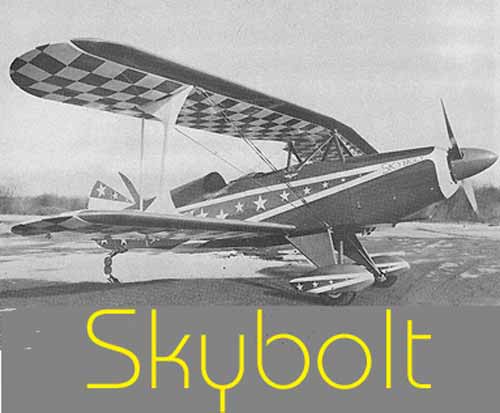|
What follows is a pilot
report on the first Skybolt the late Hale Wallace ever built. The year
was 1971. Years later Hale was to purchase the design rights and set up
his own Steen Aerolab supplying kits and components. Hale was one of the
most fantastic craftsmen I have ever known. He made “perfection”
look sloppy. He was also one of my good friends and I hated it when cancer
took him. However, even in dying, he set an example for everyone to follow.
He faced his own death with a humor and dignity I can’t expect to
duplicate. He had a little of the junkyard dog in him, a little bulldog
and a whole lot of toy terrier, as he just loved having fun with airplanes.
He was one of a kind.
My mind was yelling at me, "Aaahy, Dummy! That
was the horizon that just went by, Do something!" So, I hammered
the stick forward and punched opposite rudder, bringing the snap roll
to an unbelievably sloppy halt.
"Tilt!" my brain chided again and I obediently brought the wings
back to a semblance of level flight. I had been suckered! The Skybolt
had played around on the corners of my consciousness at the airshows for
years and I had always ignored it, passing it off as a chubby, backyard
knock-off on an S-2 Pitts. But, as I yanked and pushed my way around the
sky in Hale Wallace's Skybolt, I had the subliminal feeling that the airplane
was getting back at me and ultimately would have the last laugh.
| |
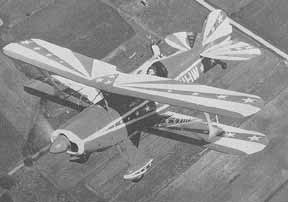 |
| |
The lines of the Skybolt are vaguely Pitts-like
in that the top wing is a swept one-piece unit, while the bottom
wings are straight. It should be noted that Curtis Pitts designed
a three-piece top wing for the current Steen Aerolab who offers
it in their on-line catalog (www.steenaerolab.com).
It is a much easier to build wing than the original. |
I had stuffed Wallace in the front pit of his airplane
so I had a two place machine that was doing what it was supposed to be
doing—carrying two people, some fuel and flip-flopping around the
sky. Wallace, of Binghamton, New York, had not only loaned me his Skybolt,
but also volunteered to play ballast bag while I poked into the various
corners of the Skybolt's soul. It was, I surmised, the worse possible
situation to place the airplane in for an aerobatic evaluation. With the
extra weight it wouldn't be performing at its best, so I could assume
that whatever I found out about it would only be improved when flying
solo. If that's the case, then as a single-place airplane the Skybolt
must be a real brain breaker because even with two of us aboard it was
no slouch.
The Skybolt bears more than a casual resemblance to a two-hole Pitts.
It's a bunch bigger, 24 versus 20-foot span, but weighs about the same,
1100 pounds empty. Wallace uses a IO-360 solid shaft 180 Lycoming and
a fixed pitched prop and weighs in at 1150 pounds, exactly what my 200
hp S-2 Pitts does with a constant speed. But, remember, the Skybolt is
a sizable amount bigger. The airplane has a "feeling" of being
bigger when you're walking around it, but its flat ground attitude tends
to hide some of its size. I think I was most impressed by its size when
I tossed my butt up over the gunwhales and settled into the seat. The
flight deck is so large that it makes my Pitts seem like a chrome-moly
straightjacket (which it is) by comparison. No problem getting my pointy-toed
Texas wedgies past the seat to -the rudder pedals in a Skybolt.
The gestation of the Skybolt is a well known and, at this point, often
told story. LaMar Steen, school teacher, wanted an aerobatic airplane.
So he designed one. Students at Manual High in Denver built it. He flew
it, liked it. Had the structure analyzed by engineers. Others liked it.
More built.
That's where it came from, but, as I flipped the master on and wobbled
up some fuel pressure, I wanted to find out where it is right now. I wanted
to know what kind of bird it is in the air, not on the drawing board.
So, keeping the mixture lean, I pushed the starter switch, and, as it
began to light off the residual fuel in its intakes, I pushed the mixture
forward and settled back to follow the Lycoming wherever it wanted to
take me.
As I taxied out, making gentle "S" turns to see around the ridiculous
snout all biplanes seem born with, I worked the controls, trying to get
a feel of what moved what. I wished that I could have done the same thing
on a number of other Skybolts because I can't believe they all feel as
good as Wallace's. Slick is the only word to describe it. The only friction
in the entire airplane was between my tusche and the seat because the
throttle, stick, rudders, everything, felt like they were stuck in butter,
with virtually nothing touching them. That's probably a credit to Hale
Wallace's meticulous building techniques rather than the basic design,
but it's hard to tell without checking several other airplanes. (Ed note:
In later years I found that to be the case because the ailerons on Skybolts
vary considerably according to the builder.)
| |
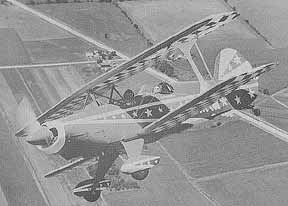 |
| |
There is also a different landing gear
for the Skybolt now available that is a single leg per side, ala
Marquart Charger, with internal shock system. |
You sit low in a Skybolt. Or at least I do. It's traditional
biplane all the way, making the pilot look like a midget in a manhole.
I've always felt I looked like the caricature "Kilroy's Been Here,"
with my eyes and nose the only thing higher than the cockpit combing.
We were working off Sussex International's runways in New Jersey and even
with their adequate width, you don't see much pavement from the back of
a Skybolt. So, as I picked my way through the puddles of a traditional
messy East Coast spring, I carefully sized up the runway that was visible
and decided to keep the sides right where they were during the takeoff
and landing rolls.
We had a fairly healthy crosswind so I was cautious with everything on
that first takeoff. I fed the coal to the Lycoming slowly at first, letting
us pick up speed at about the same rate my brain was functioning. No reason
to scare the hell out of myself by dropping the hammer too hard. The Skybolt,
even with only 180 hp did its best to play fighter, and tore down the
painted stripe as if it had someplace to go in a hurry. I hoisted the
tail just a little and sat there, tail low and peeking at both sides of
the runway at once, while we raced up to a speed where airplane thought
it'd like to go flying.
At no time, not even in the crosswind, did I have to do a tap dance on
the rudders. It took a little pressure one way or the other, but for the
most part the airplane shot straight ahead with no tendency to ricochet
off runway lights on either side. It seemed to have a surprising amount
of directional stability.
For some reason or other I wasn't really aware of rocketing down the runway
with the noise and wind threatening to yank my head off, my eyes clicking
back and forth from side to side and all the other excitement that usually
comes with taking off in a Pitts or something similar. The headsets kept
out most of the racket, but otherwise, everything happened at a very easily
handled, albeit sometimes fast, speed. When the airplane lifted off at
about 65 IAS, it had no tendency to sag, rock, rumba or otherwise keep
you busy. I did notice, with a certain amount of delight, that I was fighting
the gusts with four of the smoothest, lightest ailerons I've had the fortune
to run around with. They were much, much lighter than I had anticipated.
The Pitt's are a fair amount heavier and a Starduster's seem set in concrete
by contrast. (Ed note: this is definitely not the case with all Skybolts)
| |
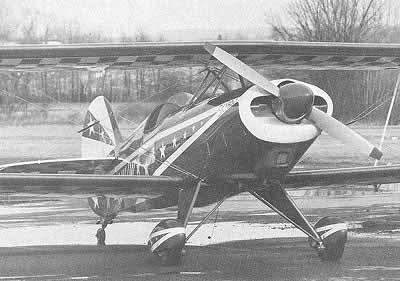 |
| |
Steen Aerolab has been experimenting with
an oil-damped, spring-oleo arrangement on the Skybolt, but it may
or may not be available to the public yet. |
At 85-90 mph climb speed, the VSI was showing about 1000
fpm which pretty well checked with what Mickey's sweep second hand was
telling me. At that rate, and considering the cool temperature, the Pitts
would out climb it easily. However, this is also where the constant speed
prop and extra 20 horses would make itself known. I forgot to ask Hale
what the pitch was on his prop, but judging from how it reacted in later
akro work, I'd guess he had a fairly coarse pitched set of blades up front.
At altitude I quickly reefed it around in a series of 90-degree turns
looking for traffic. Satisfied there weren't any Wichita sheet metal surprises
around, I reached into a corner with the stick and watched the Skybolt
turn Jersey upside down at least once, or was it twice? The silky ailerons
make any kind of roll a super sexy, kinetic affair. But that was to be
expected. Out of the roll I pulled around into the first quarter of an
inside rolling 360 and as I pushed it around for the negative portion
of the turn, got my first hint at a problem area.
Then, I pulled the nose up, hesitated and rolled over on my back, pulling
the nose through into a split-S, gaining speed for a couple of loops,
some rolls on a forty-five degree up line and a few things neither one
of us could identify. I can name what they were supposed to be, but there's
no reason to embarrass myself.
The first thing I noticed after cavorting for a while was that the Skybolt
doesn't accelerate downhill nearly as fast as the Pitts, nor does it fly
away from a stalled or nearly stalled situation as well. This would be
expected for a bigger airplane with less horsepower. I found it difficult
sometimes to get the entry speed I wanted fast enough because I had to
keep the throttle well back to keep from overspeeding the engine. That's
where the constant-speed prop is a neat piece of hardware to have on board.
| |
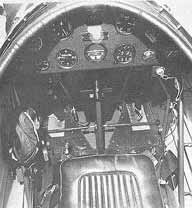 |
| |
The Skybolt is built for bigger butts because
Lamar Steen was, himself, not likely to fit into a Pitts. |
At one point I was diving and, as I went through 140
mph, I figured, "What the Hell, why not?" So, I whipped it over
inverted and pushed for all I was worth. I heard things starting to pop
in my shoulder and that was the second hint that the elevator pressures
when outside were something to be reckoned with. The airplane arced gracefully
upwards in an outside push-up, but believe me, spectators couldn't appreciate
the amount of muscle (of which I'm in short supply) it took to push it
around.
As we leveled out and stuffed our innards back into their proper positions,
Hale commented through the intercom that he had never pushed the airplane
outside like that before. I was entirely satisfied with the way the airplane
handled, so I naturally had to take advantage of the situation by offering
to take his aerobatic virginity for him. He half turned his head to give
me a dirty look, so, I explained that I believed firmly in Frank Price's
famous saying "If you ain't been outside, you ain't been nowhere."
He smiled (grimly) and nodded his head.
It's always a kick to take a guy around in his first outside loop from
the top, especially in his own airplane. So, I throttled back and waited
until the speed dipped towards 70 mph. Checking the wing tips to be sure
I was level, I began the gentle push followed by rapidly increasing control
movements that always occur in that downhill race for the bottom. I monitored
the airspeed carefully and played the G's to give me 160 mph on the bottom.
The airplane had a very, very nice acceleration rate that allowed me plenty
of time to level the wings as we were tucking the nose under. It was an
absolutely no sweat operation and as we streaked under the bottom, both
of us being cut into small sections by the various straps holding us in,
I was able to open up the arc a little and play the airplane up to the
top in what felt like a reasonably round loop. Of course, anybody watching
would have thought we were doing an outside egg or inverted pear or something,
but it felt good and only took 3 negative G's.
I had cranked in full down trim before pushing over into the outside loop
but even so the stick pressures fought me all the way around. I would
have preferred to see minus 3.5 or so on the G meter when we surfaced,
but as it was the stick made me feel as though we were going to get a
solid minus six. Apparently this is a common gripe because Steen is reportedly
changing the plans to include servoed trim tabs on the elevators as well
as a quick acting trim system a la Pitts S-2.
Somewhere along the line, I was watching the speed work its way back through
115 mph when I yanked the stick back into the right corner, stomping rudder
at the same time. Wham! The aforementioned snap roll suddenly got my undivided
attention. I guess I've snapped as many airplanes as most folks but it's
seldom that I get much of a surprise. Even so, the Steen did hand me a
surprise. Without doing some measuring it's dangerous to say how fast
an airplane is actually going around, but I know for a fact that the Skybolt
snaps faster than a Pitts S-2 and darned near as fast as a single-hole
Pitts. Even better than that, it stops where you, want it to, but you'd
better decide well in advance where you want to end up.
Unfortunately, the combination of its size and fixed high prop won't let
it fly away from a snap as well as I'd like. It does far better than any
other two-place homebuilt I've flown (I haven't had a chance at the two-place
Acroduster). Interestingly enough, the airplane snaps very well, although
slower, to the left, something you just can't get a two-hole Pitts to
do.
It spins extremely well and both the going-in and the coming-out are clean
and crisp because of the fat rudder and the big elevators. I wasn't exactly
stopping it on a dime, but with a little practice I would have figured
it out. It doesn't spin any faster than most airplanes of its type, none
of which is appreciably faster spinning than Cessna 150 when it's really
wrapped up.
When I first laid it over on its back, I was a little disappointed, because
it wants a bit more forward stick/trim than a Pitts, but a lot less than
a Starduster Two (which isn't really a fair comparison). Also, even a
bunch of forward trim won't take all the stick pressure off, although
I'm not sure I had the trim full against the stop. A Pitts will motor
along upside down all day hands off with only a little forward trim. Don't,
however, construe this to mean that the Steen was running around nose
high when inverted. The actual flight attitude seemed about the same as
a Pitts, which is about as flat as airplanes ever fly with the pilot pointed
the wrong way. Controlability and pitch stability when inverted was really
excellent. There was no tendency to have to fight to maintain a given
nose attitude.
As we let down towards the airport I once again reminded myself that somebody
somewhere has to come up with a biplane that you can see out of. To be
safe in the Skybolt (or a Pitts or a Starduster, etc.) you have to jink
the nose back and forth to see anything smaller than an L-1011 that's
in front of you. It is quite possible to design fuselages for bipes that
let you see, although the Acroduster One is the only airplane I can think
of right now that is so designed. Threading your way through the fog of
airplanes that surround most airports these days is no fun in an airplane
with the visibility of a timid turtle.
80-85 mph was the right number on final and I had to work a little to
keep the IAS needle anywhere close because of the bumps we were punching
through. A little wing down and some opposite rudder kept us lined up
and I had to kill the power completely to get down where I wanted. In
the same situation a Pitts or Starduster would have fallen out of the
sky much faster.
Closer, closer until I could see the edges of the runway where I wanted
them and I began a flair to skate gently across the invisible surface
of ground effect. Feeling for the ground wasn't really necessary because
the airplane seemed to naturally settle into the right attitude. All I
had to do was hold it as it kissed the runway with all three. I was all
eyes and nerve ends waiting for the airplane to demonstrate any bad manners
it had on the runway but it appeared to have none. Its gear seemed to
be just soft enough (the result of a fortunate choice of bungee cords)
to absorb the landing shock without being so soft that it waddled or so
hard that you skipped along rather than rolling.
A little rudder one way or the other kept things reasonably close to straight
until we braked to a halt. The rollout had been disappointingly uneventful
considering the wind and the reputation little biplanes have. In the same
situation, a Pitts S-2 or Starduster would have me doing more of a rudder
bar tango to stay on the centerline.
Does Hale Wallace like Skybolts? He must because he's building another
one, this one with a (are you ready for this?) IO-540 Lycoming with 260
fire breathin' horses. That will get the power-to-weight ratio down awfully
close to 6 lbs./hp, which is darned close to a single-hole Pitts' ratio.
What had been a spirited airplane is going to become a flaming tiger!
The Steen Skybolt will never be able to match maneuvers with a single-hole
Pitts, or a Stephens Akro. But, it's not fair to expect it to. The Steen
is a two-place airplane whose role in life is to offer an upside down
view of the world that can be shared with a friend. It would probably
do fairly well in Akro competition up through intermediate, but it will
never win. That is the domain of the single place birds. However, there
is something a one-hole machine can never give its owner—the satisfaction
of introducing someone else to the world of biplanes and aerobatics. And,
that's what two-place machines are all about
|
Buying a used 'Bolt?
It's hard to know how many Skybolts have been built, but it is certainly
in the hundreds. Considering that it is a huge project, as any homebuilt
project is, it is "huger" by virtue of the fact that it's
a biplane and a big one at that. Still, many have been finished
and are offered for sale. When considering this route, remember
that these are homebuilt airplanes and, unless they used major components
from Steen, you have to consider the craftsmanship of the individual
building it: not everyone is a Hale Wallace, in that regard. Also,
make sure they followed the plans rather than getting creative,
when they don't have the engineering background to know what they
are doing. Also give preference to airplanes that are as close to
factory specs as possible, in regards to weight. If an airplane
is way under priced, if you check closely, you'll find there is
a reason why and you should probably walk away from it. |
|
Thinking About
Building a Skybolt?
First, go take a cold shower. When dried off, take another one!
Building an airplane, any airplane is a major project and you're
looking at 3,000-4,000 hours to build a Skybolt. Minimum! Nothing
about it is complicated, but there is a lot of it. No different
than any other airplane its size. Buying components from Steen Aerolab
increases the price, but it also increases the probability that
you'll finish it.
You don't need 250 hp to make the airplane fly
well, but, if using a 180-200 hp Lycoming, the airplane will fly
much better if you really keep it light. Weight is almost always
the result of careless application of paint and carrying around
interiors and instrument panels that are far more than the airplane
needs. Remember, if it's not in the airplane, it can't break and
if it's not in the airplane, you don't have to lift it.
|
|
